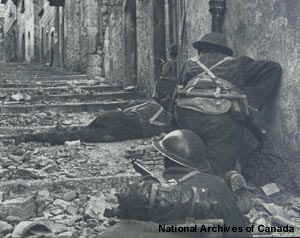 The Statute of Westminster in 1931 had made Canada a fully independent nation with the right of discretion in matters of war and peace – a power that it had lacked in 1914. As the world lurched from crisis to crisis in the 1930s, it grew increasingly obvious to all but the most hopeful observers that the First World War, supposedly the ‘war to end all wars’, would prove only the opening round of a continuing conflict.
The Statute of Westminster in 1931 had made Canada a fully independent nation with the right of discretion in matters of war and peace – a power that it had lacked in 1914. As the world lurched from crisis to crisis in the 1930s, it grew increasingly obvious to all but the most hopeful observers that the First World War, supposedly the ‘war to end all wars’, would prove only the opening round of a continuing conflict.
There was no doubt as to what Canada’s position would be: in the event of war between Britain and any combination of enemies threatening the survival of the ‘Mother Country’, Canada would support Britain. When the time came, Canada quickly offered its aid, not with wild enthusiasm as in 1914, but with grim determination.
In August 1939, Nazi Germany concluded a non-aggression pact with the Soviet Union and prepared to invade Poland, whose security Britain and France had pledged to uphold. On September 1, Germany struck; two days later Britain and France declared war on Germany. One week later, on September 10, Canada, acting in its own right, declared war on Germany. The Second World War had begun.
From a population of only 11.5 million, slightly more than one million Canadians served in uniform during the conflict. Overseas, following the tragedies of Hong Kong (December 1941) and Dieppe (August 1942), Canada’s army distinguished itself in Sicily (July-August 1943), Italy (September 1943 to February 1945), and the invasion and campaign in Normandy (June 6 – August 22, 1944), and throughout the campaign to liberate northwest Europe until victory in May 1945.
The Royal Canadian Navy (RCN) grew 50-fold to a force of nearly 100,000 and played a crucial role in winning the Battle of the Atlantic and maintaining open the vital sea lanes to Britain in the face of a determined German submarine offensive. The RCN also served in the Mediterranean, Caribbean, Pacific, and Arctic. At war’s end it had become the world’s third-largest navy.
From a meagre force of largely obsolete aircraft in 1939, the Royal Canadian Air Force (RCAF), which enlisted almost 250,000 men and women during the war, came to be an essential player in the Allies’ gaining air superiority in Europe and in mounting devastating bomber raids against enemy targets. The RCAF also operated the Canada-based British Commonwealth Air Training Plan, which trained over 131,000 Commonwealth and Allied aircrew to carry the war into Germany and German-held territory.
These military contributions helped win the war, but the cost was high: more than 42,000 Canadians lost their lives, and another 55,000 were wounded.
On the home front, industry produced massively to support the war effort. Canada produced warships, merchant vessels, bombers, fighters, tanks, vehicles of all kinds, artillery pieces, and all sorts of military equipment and munitions, employing millions of people directly or indirectly. Farms produced immense amounts of meat, grain, and other produce to help keep Canada, Britain, and the Allies fed and fighting. It was a phenomenal accomplishment.
The Canadian Battlefields Foundation honours the service, achievements, and sacrifice of all Canadians who helped fight and win the Second World War in the name of freedom from tyranny.
